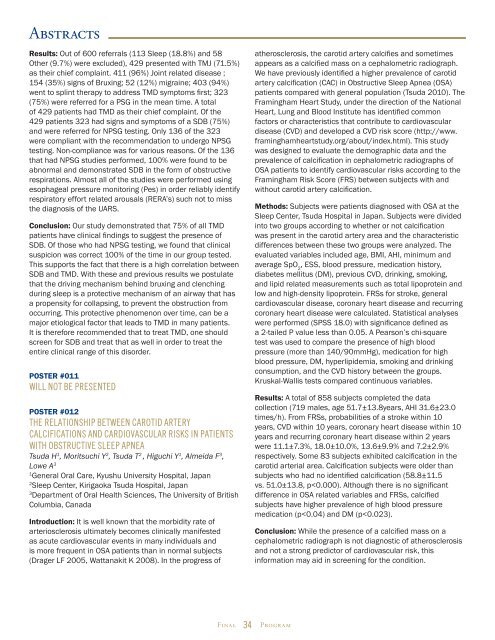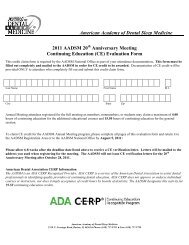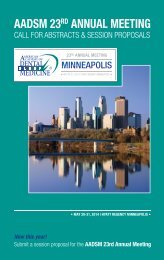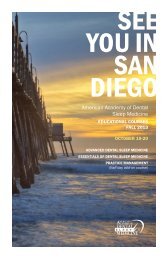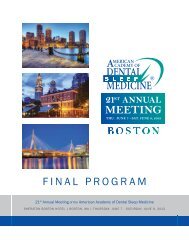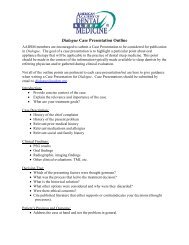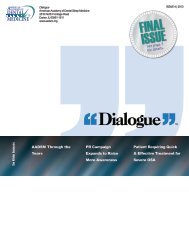FINAL PROGRAM - The American Academy of Dental Sleep Medicine
FINAL PROGRAM - The American Academy of Dental Sleep Medicine
FINAL PROGRAM - The American Academy of Dental Sleep Medicine
Create successful ePaper yourself
Turn your PDF publications into a flip-book with our unique Google optimized e-Paper software.
Abstracts<br />
Results: Out <strong>of</strong> 600 referrals (113 <strong>Sleep</strong> (18.8%) and 58<br />
Other (9.7%) were excluded), 429 presented with TMJ (71.5%)<br />
as their chief complaint. 411 (96%) Joint related disease ;<br />
154 (35%) signs <strong>of</strong> Bruxing; 52 (12%) migraine; 403 (94%)<br />
went to splint therapy to address TMD symptoms first; 323<br />
(75%) were referred for a PSG in the mean time. A total<br />
<strong>of</strong> 429 patients had TMD as their chief complaint. Of the<br />
429 patients 323 had signs and symptoms <strong>of</strong> a SDB (75%)<br />
and were referred for NPSG testing. Only 136 <strong>of</strong> the 323<br />
were compliant with the recommendation to undergo NPSG<br />
testing. Non-compliance was for various reasons. Of the 136<br />
that had NPSG studies performed, 100% were found to be<br />
abnormal and demonstrated SDB in the form <strong>of</strong> obstructive<br />
respirations. Almost all <strong>of</strong> the studies were performed using<br />
esophageal pressure monitoring (Pes) in order reliably identify<br />
respiratory effort related arousals (RERA’s) such not to miss<br />
the diagnosis <strong>of</strong> the UARS.<br />
Conclusion: Our study demonstrated that 75% <strong>of</strong> all TMD<br />
patients have clinical findings to suggest the presence <strong>of</strong><br />
SDB. Of those who had NPSG testing, we found that clinical<br />
suspicion was correct 100% <strong>of</strong> the time in our group tested.<br />
This supports the fact that there is a high correlation between<br />
SDB and TMD. With these and previous results we postulate<br />
that the driving mechanism behind bruxing and clenching<br />
during sleep is a protective mechanism <strong>of</strong> an airway that has<br />
a propensity for collapsing, to prevent the obstruction from<br />
occurring. This protective phenomenon over time, can be a<br />
major etiological factor that leads to TMD in many patients.<br />
It is therefore recommended that to treat TMD, one should<br />
screen for SDB and treat that as well in order to treat the<br />
entire clinical range <strong>of</strong> this disorder.<br />
POSTER #011<br />
WILL NOT BE PRESENTED<br />
POSTER #012<br />
THE RELATIONSHIP BETWEEN CAROTID ARTERY<br />
CALCIFICATIONS AND CARDIOVASCULAR RISKS IN PATIENTS<br />
WITH OBSTRUCTIVE SLEEP APNEA<br />
Tsuda H 1 , Moritsuchi Y 2 , Tsuda T 2 , Higuchi Y 1 , Almeida F 3 ,<br />
Lowe A 3<br />
1<br />
General Oral Care, Kyushu University Hospital, Japan<br />
2<br />
<strong>Sleep</strong> Center, Kirigaoka Tsuda Hospital, Japan<br />
3<br />
Department <strong>of</strong> Oral Health Sciences, <strong>The</strong> University <strong>of</strong> British<br />
Columbia, Canada<br />
Introduction: It is well known that the morbidity rate <strong>of</strong><br />
arteriosclerosis ultimately becomes clinically manifested<br />
as acute cardiovascular events in many individuals and<br />
is more frequent in OSA patients than in normal subjects<br />
(Drager LF 2005, Wattanakit K 2008). In the progress <strong>of</strong><br />
atherosclerosis, the carotid artery calcifies and sometimes<br />
appears as a calcified mass on a cephalometric radiograph.<br />
We have previously identified a higher prevalence <strong>of</strong> carotid<br />
artery calcification (CAC) in Obstructive <strong>Sleep</strong> Apnea (OSA)<br />
patients compared with general population (Tsuda 2010). <strong>The</strong><br />
Framingham Heart Study, under the direction <strong>of</strong> the National<br />
Heart, Lung and Blood Institute has identified common<br />
factors or characteristics that contribute to cardiovascular<br />
disease (CVD) and developed a CVD risk score (http://www.<br />
framinghamheartstudy.org/about/index.html). This study<br />
was designed to evaluate the demographic data and the<br />
prevalence <strong>of</strong> calcification in cephalometric radiographs <strong>of</strong><br />
OSA patients to identify cardiovascular risks according to the<br />
Framingham Risk Score (FRS) between subjects with and<br />
without carotid artery calcification.<br />
Methods: Subjects were patients diagnosed with OSA at the<br />
<strong>Sleep</strong> Center, Tsuda Hospital in Japan. Subjects were divided<br />
into two groups according to whether or not calcification<br />
was present in the carotid artery area and the characteristic<br />
differences between these two groups were analyzed. <strong>The</strong><br />
evaluated variables included age, BMI, AHI, minimum and<br />
average SpO 2<br />
, ESS, blood pressure, medication history,<br />
diabetes mellitus (DM), previous CVD, drinking, smoking,<br />
and lipid related measurements such as total lipoprotein and<br />
low and high-density lipoprotein. FRSs for stroke, general<br />
cardiovascular disease, coronary heart disease and recurring<br />
coronary heart disease were calculated. Statistical analyses<br />
were performed (SPSS 18.0) with significance defined as<br />
a 2-tailed P value less than 0.05. A Pearson’s chi-square<br />
test was used to compare the presence <strong>of</strong> high blood<br />
pressure (more than 140/90mmHg), medication for high<br />
blood pressure, DM, hyperlipidemia, smoking and drinking<br />
consumption, and the CVD history between the groups.<br />
Kruskal-Wallis tests compared continuous variables.<br />
Results: A total <strong>of</strong> 858 subjects completed the data<br />
collection (719 males, age 51.7±13.8years, AHI 31.6±23.0<br />
times/h). From FRSs, probabilities <strong>of</strong> a stroke within 10<br />
years, CVD within 10 years, coronary heart disease within 10<br />
years and recurring coronary heart disease within 2 years<br />
were 11.1±7.3%, 18.0±10.0%, 13.6±9.9% and 7.2±2.9%<br />
respectively. Some 83 subjects exhibited calcification in the<br />
carotid arterial area. Calcification subjects were older than<br />
subjects who had no identified calcification (58.8±11.5<br />
vs. 51.0±13.8, p


